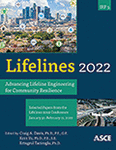Seismic Behavior of Masonry Building with Spread Base Isolation Using Natural Rubber
Publication: Lifelines 2022
ABSTRACT
Masonry is the most widely used material due to its availability and ease of construction in various rural parts of the world. The brittle nature of the masonry makes the buildings more vulnerable during an earthquake. Existing base-isolation techniques require specialized manufacturing processes, skilled labor, and uneconomical for masonry buildings. This study focuses on a novel isolation technique with locally available low-cost rubber as a cost-effective emerging solution for masonry buildings to overcome these challenges. A numerical study conducted on an experimentally validated one-story masonry building subjected to ground motion and responses are compared between fixed-base and spread rubber isolated-base buildings. The wall-top displacement, wall-top acceleration, and failure stress indicated a significant improvement in seismic performance of rubber isolated masonry building. The proposed spread base-isolation technique using locally available natural rubber can be a socio-economic solution for seismic protection of masonry buildings in developing countries’ rural seismic regions.
Get full access to this article
View all available purchase options and get full access to this chapter.
REFERENCES
Arya, A. S. (1984). Sliding concept for mitigation of earthquake disaster to masonry buildings. In Proceedings of 8th world conference on earthquake engineering, San Francisco, USA.
Balasubramanian, S. R., Vaidyanathan, C. V., Lakshmanan, N., Anoop, M. B., and Balaji Rao, K. (2010). In-plane Shear Behaviour of Unreinforced Brick Masonry–A Literature Review.
Banović, I., Radnić, J., and Grgić, N. (2018). Shake table study on the efficiency of seismic base isolation using natural stone pebbles—advances in Materials Science and Engineering, 2018.
Calabrese, A., Spizzuoco, M., Strano, S., and Terzo, M. (2019). Hysteresis models for response history analyses of recycled rubber–Fiber-reinforced bearings (RR-FRBs) base-isolated buildings. Engineering Structures, 178, 635–644.
Choudhury, T., Milani, G., and Kaushik, H. B. (2015). Comprehensive numerical approaches for the design and safety assessment of masonry buildings retrofitted with steel bands in developing countries: The case of India. Construction and Building Materials, 85, 227–246.
Chourasia, A., Parashar, J., and Chauhan, N. (2017). Confined masonry construction for India: A techno-economical solution for improved seismic behaviour.
Coburn, A. W., Spence, R. J., and Pomonis, A. (1992, July). Factors determining human casualty levels in earthquakes: mortality prediction in building collapse. In Proceedings of the tenth world conference on earthquake engineering (Vol. 10, pp. 5989–5994). Balkema Rotterdam.
Kelly, J. M., and Calabrese, A. (2012). Mechanics of Fiber-reinforced bearings. Berkeley, CA: Pacific Earthquake Engineering Research Center.
Kelly, J. M., and Takhirov, S. (2001). Analytical and experimental study of fiber-reinforced elastomeric isolators. Pacific Earthquake Engineering Research Center, College of Engineering, University of California, Berkeley.
Kelly, J. M., and Takhirov, S. M. (2002). Analytical and experimental study of fiber-reinforced strip isolators. Pacific Earthquake Engineering Research Center.
Lou, Y., Wang, M., and Su, J. (1992, July). Research of sliding shock-absorbing multi-story brick building. In Proceedings of 10th world conference on earthquake engineering, Barcelona, Spain.
Nanda, R. P., Shrikhande, M., and Agarwal, P. (2015). Low-cost base-isolation system for seismic protection of rural buildings. Practice Periodical on Structural Design and Construction, 21(1), 04015001.
Qamaruddin, M., Rasheeduzzafar, Arya, A. S., and Chandra, B. (1986). Seismic response of masonry buildings with sliding substructure. Journal of Structural Engineering, 112(9), 2001–2011.
Sierra, I. E. M., Losanno, D., Strano, S., Marulanda, J., and Thomson, P. (2019). Development and experimental behavior of HDR seismic isolators for low-rise residential buildings. Engineering Structures, 183, 894–906.
Tsai, H. C., and Kelly, J. M. (2002). Stiffness analysis of fiber-reinforced rectangular seismic isolators. Journal of Engineering Mechanics, 128(4), 462–470.
Tsang, H. H., Lo, S. H., Xu, X., and Neaz Sheikh, M. (2012). Seismic isolation for low‐to‐medium‐rise buildings using granulated rubber–soil mixtures: a numerical study. Earthquake engineering & structural dynamics, 41(14), 2009–2024.
Turer, A., and Özden, B. (2008). Seismic base isolation using low-cost Scrap Tire Pads (STP). Materials and Structures, 41(5), 891–908.
Ucar, H., and Basdogan, I. (2018). Dynamic characterization and modeling of rubber shock absorbers: a comprehensive case study. Journal of Low Frequency Noise, Vibration and Active Control, 37(3), 509–518.
Yuan, K., Zhang, J., Guo, J., and Tian, W. (2019). Study on Seismic Response Characteristics and Design Parameters of Composite Isolation System for Rural Buildings. KSCE Journal of Civil Engineering, 23(4), 1747–1755.
Information & Authors
Information
Published In
History
Published online: Nov 16, 2022
Authors
Metrics & Citations
Metrics
Citations
Download citation
If you have the appropriate software installed, you can download article citation data to the citation manager of your choice. Simply select your manager software from the list below and click Download.
